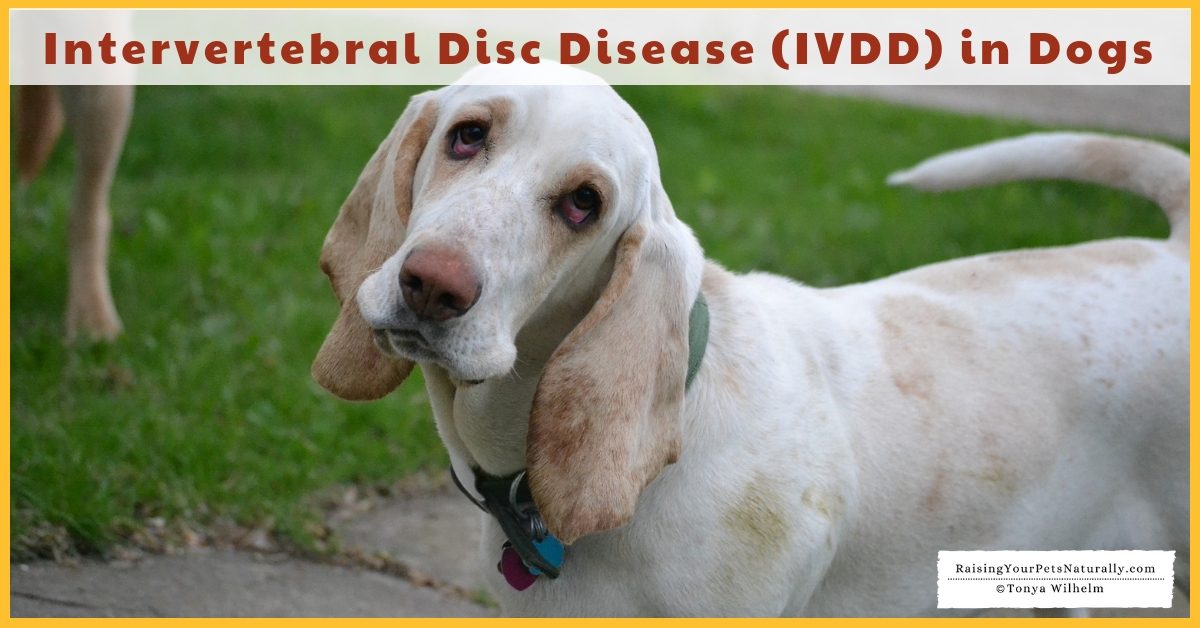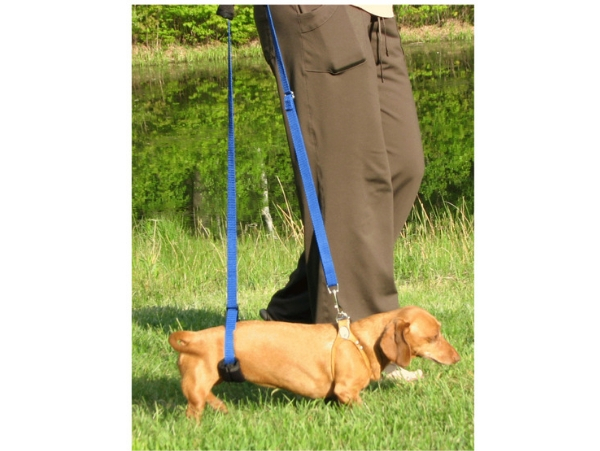Treatment Options for IVDD in Dogs

Disclaimer: This is a sponsored post. However, I will always offer my readers an unbiased and honest account of my experiences. Your trust is very appreciated, and never taken for granted. ~Tonya, Dexter and Angel Nutter
When I set out to write about intervertebral disc disease in dogs, I knew I would need a veterinarian expert well-versed in the subject. I didn’t want to just gloss over the subject and leave you with more questions than you had answers. So I reached out to one of Dexter’s veterinarians, Dr. Lindsay VanHusan. Not only is Dr. VanHusan an amazing veterinarian, but she’s also a Mom to two long dogs, a dachshund and basset hound. Her basset hound recently had surgery for IVDD. She graduated from Miami University in 2003 with a major in psychology and a minor in neuroscience and from Michigan State University College of Veterinary Medicine in 2007. She’s been a private small animal practitioner in Michigan and Ohio since then and has developed a love for dentistry, senior/geriatric care, and pain management. She fosters a relationship with clients in which she gives them all diagnostic/treatment options and supports their decisions for treatment; trust is extremely important to her as she thinks that it results in the best care for pets. I felt she would be the perfect expert for this piece.
Intervertebral Disc Disease / IVDD Surgery Recovery with a GingerLead Dog Sling
What exactly is intervertebral disc disease (IVDD) in dogs?
Dr. Lindsay VanHusan: To understand intervertebral disc disease (IVDD), it’s important to understand the anatomy of the spine. The spine is not a single long tube, but rather is composed of several parts. The spinal cord is a bundle of all of the nerves that travel from the brain to the rest of the body. There are bones called vertebrae, which surround and protect the spinal cord, that allow for flexibility of the spine. There are joints called discs located between each vertebra in the spine. These provide cushion to absorb shock along the spine. Finally, there are ligaments that line the spinal cord that keep the disc material in its place.
IVDD is when the soft disc material ruptures out of its space (“disc herniation”) and presses painfully on the spinal cord. There are two types of IVDD – Hansen type I and Hansen type II. Type I occurs when the ligament becomes brittle and dehydrated, and disc material ruptures suddenly and presses onto the spinal cord, causing bruising, inflammation, and pain. Type II occurs when the vertebra slowly compresses the disc, and the ligament becomes soft, allowing the disc material to press on the spinal cord.
What are some common symptoms?
LV: The most common presenting complaints of owners of dogs with IVDD are a dog who is suddenly reluctant to move, trembling/shaking, won’t eat or drink (probably because it is too painful to walk to their dishes or because they are simply too painful in general), and isn’t jumping onto the furniture like usual. Often, the owner will also mention that their dog vocalized in pain when they picked them up, although the owners haven’t touched them in any unusual way, or vocalizes in pain randomly when moving. Occasionally, the dogs stand or walk with a hunched position to their spine. More severe cases with neurologic deficits include dragging paws or being unable to walk.
How is IVDD diagnosed?
LV: There are three steps in diagnosing IVDD:
- Physical exam: a veterinarian will perform a complete physical exam, including a neurologic exam. This involves testing certain reflexes in order to localize the lesion and additionally palpating for pain along the spine.
- Radiographs: Radiographs of the spine can be performed to screen for broken vertebrae, tumors, or compressed or mineralized discs. They do not show normal discs or discs that have ruptured acutely. This testing can be performed by your general practitioner.
- Advanced imaging: If surgery is being considered, an MRI (magnetic resonance imaging) is necessary to diagnose and localize the lesion(s). This is a test that is performed by a veterinary neurologist at a specialty practice.
What are the treatment options for IVDD?
LV: There are two treatment options for management of IVDD – medical and surgical treatment.
Medical management should be considered when a pet is painful, but does not have significant neurologic deficits (ex: back pain, but is able to walk). It typically involves oral steroids to reduce inflammation, pain management (typically multi-modal, which means using more than one type of pain medication), and, most importantly, STRICT REST. This means cage rest if at all possible, with absolutely no running, jumping, stairs, or play. This is typically the most difficult part for pet owners, particularly when their pets start to feel better, however it is CRITICAL to restrict activity for a minimum of 2-3 weeks.
Surgical management is typically recommended for dogs with persistent or uncontrollable pain, who are unable to walk, or who do not improve, or who worsen with medical management. Surgery is performed by a veterinary neurologist after an MRI is performed. The goal of surgery is to remove the disc material from the spinal cord, which allows for the best possible outcome. Time is of the essence, as the longer a dog is unable to walk, the poorer the results of treatment. For example, my dog, 12 y.o. basset Ruby, became suddenly painful and unable to use her back legs at 8:30 a.m., and we were able to get her to the neurologist and into surgery within 7 hours. She was able to start walking a week after surgery and has slowly continued to improve since then 
If you find your dog suddenly seems painful or cannot walk, please take him to your veterinarian immediately or the nearest emergency clinic. As Dr. VanHusan mentioned, time is of the essence. If your dog does need surgery, he will need walking assistance during his recovery. The GingerLead Dog Support and Rehabilitation Harness is a great option. GingerLead is a padded support sling and a great aid for dogs not able to move their hind legs properly. Using it provides your dog with much needed support and stability while cradling their belly in comfort, making it significantly easier for them to walk and increasing confidence by keeping them from falling down.

Why do dogs get IVDD?
LV: Type I disc disease can occur in any breed (and rarely cats), but typically occurs in young dogs with long backs and short legs (dachshunds are #1), although other breeds most at risk include beagles, poodles, and basset hounds. Active dogs who JUMP are most at risk.
Type II disc disease is seen most classically in older, large-breed dogs such as German Shepherds. It occurs as there is slow degeneration of the ligament that holds the disc in its normal place.
Misc. Facts:
- There are dogs who have one episode of IVDD in their lives and others who have multiple episodes, either of the same disc or of multiple disc spaces.
- Dogs who have had surgery are much more likely to rupture another disc if they are allowed to jump. In our home, we utilize baby gates, we block furniture so the dogs can’t jump onto it unless we are there, and we try to carry them up and down stairs as much as possible.
- It is important to keep these dogs slim – extra weight adds extra strain on the back.
- Glucosamine supplementation does not appear to benefit the spine itself, although it can help protect the other joints in the limbs. IVDD dogs sometimes bear weight unevenly, putting more strain on some joints than others, so I still strongly recommend glucosamine supplementation.
- Laser therapy can be extremely helpful for alleviating muscle spasms.
I wanted to thank Dr. VanHusan for her time and expertise and wish Ruby a continued successful recovery.
If your dog develops intervertebral disc disease or any other condition, try not to let his diagnosis get you down. It’s important to LIVE each day to the fullest and look for ways to help your dog have a good quality of life. Luckily, there are a lot of natural treatments, physical therapy options, and products such as the GingerLead that can greatly improve your dog’s quality of life. Be your dog’s voice and find answers; he deserves it.
Are you looking for even more ways to stay up to date with Raising Your Pets Naturally? Sign up for the newsletter for more tips and promotions. Don’t forget to be social and Like, Follow and Subscribe. Comments below are always welcome.




Thank you so much for sharing this. My vet told me about this disease when I got my two little guys. Their long bodies are prone to this, according to her.
I’m so glad your vet shared with you and is promoting being aware. That’s a great vet!
I wasn’t even aware this existed. This sounds so painful for those poor pups I am glad vets and an assortment of helpful products are able to help the dogs live a better life.
I am glad vets and an assortment of helpful products are able to help the dogs live a better life.
It was new to me too. I knew about it, but not the real details.
I’ve never heard of IVDD before now! Thanks a lot for the information, this is important to know especially that we’re planning on getting our first dog yay!
Happy to share. Good luck on the new dog.
Really interesting read! I’ve never heard of IVDD before so it was very informative!
Happy to share. Thank you.
Thanks for sharing about this disease which will help dogs get treated.
Glad to share the knowledge.
Wow, how informative! I had no idea this was an issue. I wonder if it’s a problem for cats too?
Thanks, Sarah. She said a very uncommon disease for cats, but can happen.
I’m so glad to hear she had a specialist help you out! Spinal conditions can be so delicate, and especially with pets I would be so concerned.
Yes. Specialist really are key to treatment for this disease.
Oh that is so sad when our animal babies get sick Glad I haven’t had to deal with this but still good to know
Glad I haven’t had to deal with this but still good to know
Hate seeing our pets not well. I’m just glad when caught, there are things we can do to help and manage IVDD.
I don’t think I have ever heard of this before. I’m really glad you shared this. I love to read up on things like this when it comes to our pets. It’s nice to know.
Thanks, Kathy. I’m thrilled to share. It’s always a learning process with these pups.
Oh, that is really a great to know and really interesting. Thanks for sharing this article.
Glad to share.
This is a very informative post. You have explained everything about the Intervertebral Disc Disease in detail. I’m sharing it with all of my friends who have dogs as pets. I’m sure it will create awareness and will help them take necessary precautions for their dogs.
Thank you for sharing. I really appreciate that. I can’t take the credit, that’s Dexter’s vet with all the great info.
This is so informative, I am sending your link to my sis-in-law who has lots of dogs so that she is able to spot it immediately. Thank you for the awareness
Thank you for sharing. I really appreciate that.
When we had our dog, we were very careful as to what was prescribed.
That’s good!
OMG! I have a doxie (dachshund and beagle mix) Glad I learn about what this disease is all about but I’m glad most of all of my dogs don’t have it. Thank you so much for this informative post.
Happy to share. Keep them lean and fit and watch their twisting.
i never heard of this but as a dog owner myself i find thating post very informative indeed
Thanks, Pati. I’m glad to bring awareness to IVDD and products like GingerLead that can help these pups.
This is such an important post for all dog owners to know, a great informative read!
Thank you, Lisa. I’m so glad to share.
Oh poor baby!! This is so scary but I’m glad there are advanced treatment options out there. Thank you for sharing.
Happy to share. Yes, we have to be very aware and quick for the best treatment options.